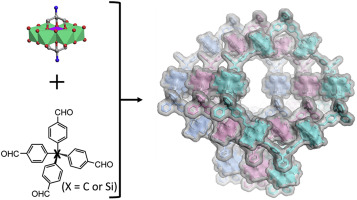Microporous and Mesoporous Materials ( IF 4.8 ) Pub Date : 2020-02-19 , DOI: 10.1016/j.micromeso.2020.110105 Xiuqin Yu , Cuiyan Li , Yunchao Ma , Daohao Li , Hui Li , Xinyu Guan , Yushan Yan , Valentin Valtchev , Shilun Qiu , Qianrong Fang

|
The development of covalent organic frameworks (COFs) with new building units is of critical importance for enriching the structural diversity and expanding their functions. However, the construction of COFs has been thus far limited primarily to traditional organic linkers. Herein, we report three-dimensional porous crystalline covalent polyoxometalate-organic frameworks (CPOFs) constructed from both inorganic and organic building blocks with reversible covalent bonds. These highly crystalline CPOFs exhibited 3-fold interpenetrated diamondoid topology, permanent porosity and high stability. Furthermore, these CPOFs could be directly applied as anode materials for lithium-ion batteries (LIBs) and displayed high reversible capacity (as high as 550 mA h g-1), rate performance, and cycling stability (up to 500 cycles).
中文翻译:

锂离子电池的多孔结晶共价多金属氧酸盐-有机骨架
使用新的建筑单元开发共价有机框架(COF)对于丰富结构多样性和扩展其功能至关重要。然而,迄今为止,COF的构建主要限于传统的有机连接基。在本文中,我们报道了由具有可逆共价键的无机和有机结构单元构建的三维多孔晶体共价多金属氧酸盐-有机骨架(CPOF)。这些高度结晶的CPOF具有3倍互穿的类金刚石拓扑,永久孔隙率和高稳定性。此外,这些CPOF可以直接用作锂离子电池(LIB)的负极材料,并显示出高可逆容量(高达550 mA hg -1),速率性能和循环稳定性(最多500个循环)。










































 京公网安备 11010802027423号
京公网安备 11010802027423号